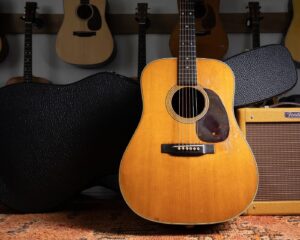If you want to purchase a vintage guitar, your wallet will take a hit. That’s why you must research and educate yourself on the instrument you are interested in.
Guitars are highly modular instruments, and guitarists are tinkerers by nature. Therefore, adding or replacing parts can significantly affect a tool’s value. For example, a replacement pickup will decrease the value of a Gibson D-45.
Age
 Many people who buy vintage guitars are looking for some sort of mojo – the idea that certain things, like instruments, can become more magical simply by getting older. Of course, this could be entirely mystical, and it depends on the individual – but there is no doubt that some guitars do seem to sound better with age.
Many people who buy vintage guitars are looking for some sort of mojo – the idea that certain things, like instruments, can become more magical simply by getting older. Of course, this could be entirely mystical, and it depends on the individual – but there is no doubt that some guitars do seem to sound better with age.
This has something to do with the factor such as wood ages. The pores in wood can widen over time, resulting in the wood drying out and changing its tone, vibrations, and resonance. This procedure is accelerated by exposure to the elements or playing the instrument.
One vital factor that can affect the value of a vintage guitar is whether or not it has been refinished. Many collectors are very picky about this, as a refiner can reduce the weight of a guitar by up to a third. However, generally speaking, the original finish of a guitar is preferable, as this usually reflects the style and norms of the era in which it was made.
However, It should be noted that a guitar can still be considered vintage if it has been refinished recently and was initially done well. If a guitar was refinished in the 70s, for example, it may still be worth quite a bit, as it would have been made when the refinishing techniques of that period were at their best.
Materials
Guitars are highly modular instruments by design, so many guitarists will replace parts to improve or customise their devices. However, if these changes detract from the originality of an agent, they may diminish its value in a collector’s eye. Examples include re-fretting a guitar or replacing its pickups.
Guitars are also prone to breaking, especially older models from Gibson. The headstock, the angled part of the guitar’s neck to which the strings are attached, is under a lot of pressure from the high tension of the line and can be vulnerable to cracks or breaks. Luckily, headstock breaks are relatively common for luthiers to repair, but they will devalue a vintage guitar.
The quality of the materials used in a vintage guitar can also play an essential role in its overall tone and feel. Wood can be a significant component of this, as it impacts an instrument’s overall sound and resonance. Historically, some manufacturers used cheaper materials to cut costs, often resulting in poorer overall quality. On the other hand, some guitar makers have gone above and beyond to use quality wood, even when this was more expensive.
Another thing to consider is whether or not a vintage guitar was built with ethically sourced materials. For instance, some older guitars were made with rare and exotic woods harvested and exported illegally. This can significantly impact the quality and value of an instrument, so do your research before buying.
Hardware
Whether it be wood, hardware or other components, the materials that make up vintage guitars can tell a lot about their overall quality. Guitars are highly modular instruments, and guitarists tend to be tinkerers – that can mean swapping out pickups, tuners, bridges, nuts, etc.
However, when it comes to retaining the value of a vintage guitar, replacing parts often decreases the overall value of the instrument. For example, replacing a vintage Gibson Les Paul pickup with a modern replacement may cause the device to lose some weight, especially if the originals are still in excellent condition.
The same can be said for hardware, which also plays a key role in the overall look of a vintage guitar. The original hardware on a vintage Fender Strat or Gibson Les Paul can make a huge difference in how the instrument sounds and eyes, so keeping it intact is usually best. However, in many cases, old guitars will feature hardware produced when manufacturing operations were much smaller and quality control was more strict.
As a result, some of the most sought-after vintage guitars will no longer have available hardware – such as metal tuning pegs with the Wilkinson logo or Gibson’s original Nashville-style tune-o-matic.
It’s important to note that when it comes to vintage guitars, the word “vintage” has never really meant “better.” It simply means that the instrument was made and produced in an older era, which can have some perks regarding playability or sound. Ultimately, it’s up to the individual owner of the instrument to decide if they feel that a vintage guitar is worth the investment.
